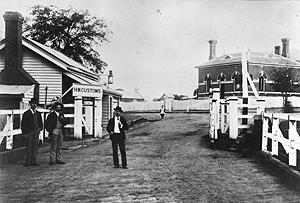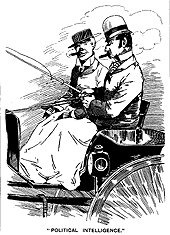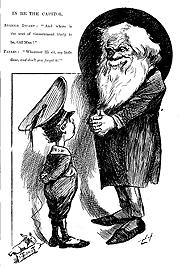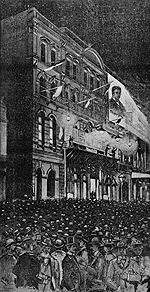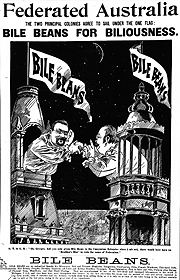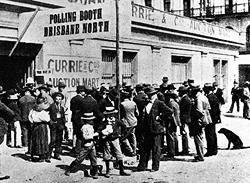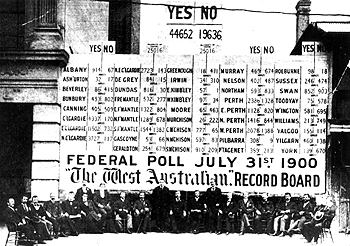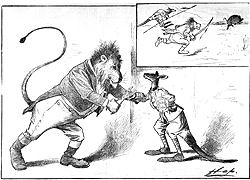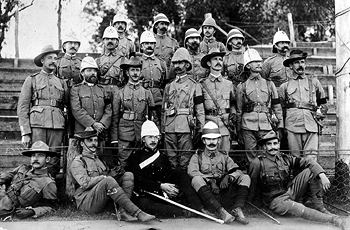By 1880, the six Australian colonies had grown into distinct and separate provinces proud of their own political institutions, defence organisations and commercial enterprises. Despite the rivalry, these six States came together in peace to form a new nation, a rare event by world standards. This online exhibition is supported by extensive teachers notes for both primary and secondary students.
Creating a nation
Show moreIn April 1899 Mr P. MacDonnell, licensee of the Punt Hotel, Gooramadda, was fined fifty pounds by the government of Victoria. He had failed to pay duty on gloves imported from New South Wales.
Less than two years later, on 1 January 1901, the customs barriers throughout Australia were torn down. On that day, the six virtually independent colonies on the continent became states of the Commonwealth of Australia. An Australian government was appointed to deal with national affairs and on 9 May the first Australian Parliament was opened in Melbourne.
The idea that the six Australian colonies ought to create some form of national government had existed since the 1850s. By the 1880s colonial leaders were becoming concerned about matters such as defence and immigration which affected the whole continent. Might not such issues be better handled by a national government?
It was only at the beginning of the 1890s that serious moves towards federation began. This exhibition tells the federal story. It follows the constitutional events of the 1890s - the conventions, the so-called popular movement towards federation, the vote on the constitution and the celebrations for the birth of the Commonwealth.
Would they go on for ever with New South Wales divided from Victoria by a narrow stream and a line of customs houses?'
Henry Parkes, speaking at the banquet for the National Australasian Convention, Sydney Town Hall, 2 March 1891.
Vigilant colonial customs officers at Her Majesty's customs station, Wahgunyah, Victoria in the 1890s.
Melbourne University Archives
The 1891 National Australia Australasian Convention
Show more"One People, One Destiny"
Australasian Convention at a banquet in the Sydney Town Hall, 2 March 1891.
Toast given by Sir Henry Parkes, Premier of New South Wales and President of the National Australasian Convention at a banquet in the Sydney Town Hall, 2 March 1891.
The man popularly credited with the first decisive move towards federation was Sir Henry Parkes, the Premier of New South Wales. Parkes persuaded the other colonial premiers to hold an Australasian Federation Conference in Melbourne in 1890. The Conference decided to call a National Australasian Convention. The purpose of this Convention was to 'consider and report upon an adequate scheme for an Australian Constitution'.
The Convention met in Sydney in March and April 1891. Each colony sent seven Members of Parliament and two even came from New Zealand. By April 9 they had hammered out a draft bill to constitute the Commonwealth of Australia. The principal draftsman and architect of the Constitution was Sir Samuel Griffith, the Premier of Queensland. Griffith was assisted by Andrew Inglis Clark, the Tasmanian Attorney-General, Charles Cameron Kingston, MP, from South Australia and Edmund Barton, MP, from New South Wales.
The Convention delegates tackled the thorny problem of how six independent governments might surrender some of their powers to a 'federal' Parliament. How could states with small populations resist the overwhelming voting power of Victoria and New South Wales? Members of Parliament from those states would dominate the proposed House of Representatives. It was decided that a Senate, in which each state would be represented equally no matter what its population, would defend the interests of the small states.
Another major problem for the Convention was the power of the proposed Senate, particularly over money. A majority of delegates from the smaller colonies favoured a second chamber which would be able to amend, although not initiate, money bills. The larger colonies thought this undemocratic as the wishes of a minority of the population could prevail over the representatives of the majority. At this point the Constitution would not have been accepted without the delegates' agreement to the great 'Compromise of 1891'. This restricted the Senate's powers over money bills. The Senate could not itself make amendments to these bills, although it could request the House of Representatives to make such amendments, and, ultimately, it could refuse to pass the bills.
The people and federation - a punter's comment!
Melbourne Punch, 12 March 1891
Sir Henry Parkes - the father of Federation?
Show moreSir Henry Parkes convinced his fellow Premiers and politicians to take federation seriously at the Melbourne Conference of 1890. But his legacy to the federal movement was not in the fine detail of the Constitution. Parkes presented a vision of a united Australia and left legal definitions to others.
Parkes, however, did have a lasting effect on the way in which Australians refer to their national government. The draft constitution of 1891 called the new nation 'The Commonwealth of Australia'. The title was suggested by Parkes. Perhaps, for that alone, Parkes deserves to be remembered as the 'Father' of the Commonwealth.
Parkes died in 1896. He did not live to be the first Prime Minister of Australia, a position many thought lay at the heart of his interest in federation.
The Bulletin, 18 April 1891
Taking Federation to the people
Show more
'Today, Saturday March 12th 1898, after an all-night's sitting and under conditions of great nervous exhaustion and irritability we have practically completed the draft bill for the Constitution of the Australian Commonwealth.'Alfred Deakin, in his first-hand account of federation, first published in 1923 as The Federal Story.
The Australasian Federal Convention of 1897 and 1898 was a tale of three cities. The opening session was held in Adelaide in March 1897 where a draft Constitution was produced. Four months were then allowed for the colonial parliaments to consider and comment upon this draft. The Convention reassembled in Sydney in September and a final session was held in Melbourne in February and March of 1898. On 17 March 1898, St Patrick's Day, a Constitution was ready to place before the voters of Australia.
The Convention delegates used the Constitution of 1891 as their starting point and amended various sections. A small drafting committee then worked the Convention's resolutions into the precise language of a legal document. The members of the drafting committee were faced with a most demanding task.
A central concern to the Convention was how to resolve irreconcilable disputes over legislation between the Senate and the House of Representatives. Delegates spent hours debating this issue. Section 57 of the Constitution, the 'double dissolution' clause, provided for a simultaneous election of both the Senate and the House of Representatives. If the Senate then still refused to pass a bill, a joint sitting of both Houses could be called. In a joint sitting a three-fifths majority would be sufficient to pass a bill.
State finances also worried the colonial premiers. How would they balance their budgets if the Commonwealth government collected customs duties? It was decided that the states would receive back a fixed proportion of customs revenues in perpetuity. Because this provision would curb the spending power of a Commonwealth government, it was known as the 'Braddon Blot' after Edward Braddon, the Premier of Tasmania who devised it
The Bulletin, 18 April 1891
The Australasian Federal Convention 1897/1898
Show moreIn the early 1890s the Australian colonies descended into economic depression. In the midst of bank crashes, rising unemployment and social distress, many politicians took little real interest in federation. It was not a good time for serious consideration of an Australian constitution. By the end of 1892 the draft Constitution of 1891 had failed to make any headway in the colonial parliaments.
It became evident that to succeed federation would have to take on the appearance of a popular cause. In Victoria men like Alfred Deakin and other members of the Australian Natives Association had long worked for national unity. To stir up interest in New South Wales, Edmund Barton founded the Australasian Federation League in 1893. The League received strong support along the Murray River where the people of the border towns were daily inconvenienced by customs barriers.
At a conference of federation leagues and branches of the Australian Natives Association, held in the Murray River town of Corowa in 1893, a real link between federation and the people was forged. John Quick, a lawyer from Bendigo, successfully proposed a resolution which showed a new way forward. Each colonial parliament should pass an Act to elect delegates to another convention. This convention would draw up a constitution. The proposed constitution would then be put to the voters for approval at a referendum in each colony.
The Hobart Premiers' Conference of 1895 accepted Quick's proposal. By 1897 Enabling Acts to elect delegates to a Convention had been passed by all but the Queensland Parliament. Subsequent Convention elections revealed who the people regarded as the real supporters of federation. Leading politicians such as Alfred Deakin in Victoria, Charles Cameron Kingston in South Australia and Edward Nicholas Braddon in Tasmania were easily elected. But far above them all in the popular mind was New South Welshman, Edmund Barton. He topped the poll in his own colony - 15,000 votes ahead of his nearest rival.
The lantern slide shows Edmund Barton.
Town and Country Journal
18 March 1897
The Federal Constitutional Referendums 1898, 1899 and 1900
Show more'Anti-Billites', as they were known, tried to frighten voters with statistics. It was alleged, for example, that in New South Wales, under the proposed form of federation, every Australian would pay an extra twenty-two shillings and sixpence per year in tax.
The members of the Women's Federal League in New South Wales, none of whom had a vote, were more positive. They urged men to ignore narrow economic arguments and to vote for the Commonwealth on behalf of future generations.
On 3 and 4 June 1898, Tasmania, New South Wales, South Australia and Victoria went to the polls. One pro-federation Adelaide newspaper, conscious of the significance of the occasion, called referendum day 'The Glorious Fourth'. In these four colonies a majority voted 'Yes' for the Constitution. However, in New South Wales the Enabling Act had specified that 80,000 votes would be required for the Commonwealth Bill to pass. This figure was not reached.
The colonial premiers met in early 1899 to try to resolve this problem. They agreed to a number of amendments to the proposed constitution which would make it more acceptable to New South Wales. The 'Braddon' clause, concerning the return of customs revenue to the states, would operate for only ten years. In addition, the new federal capital was to be built in New South Wales provided it was at least a hundred miles from Sydney.
These changes were accepted by the voters at another referendum held in New South Wales, Victoria, South Australia and Tasmania. In September 1899 Queensland voted for the Commonwealth Bill. Finally on 31 July 1900 a majority of Western Australians said 'Yes'.
The Voting: North Brisbane Polling Station
The Queenslander, 9 September 1899
The tally board
Show more'When the expeditious posters placed the successively gratifying results on the board the people sent up cheers and triumphant shouts which proclaimed a decisive victory and sent a thrill through everyone with any emotional feelings'.
Description from the Adelaide Observer of the crowd at the referendum tally board in front of the Observer office, June 4 1898.
Who voted in the Referendum?
Today, all Australian citizens over 18 are eligible to vote. At the time of the federation referendums you may not have held that right. With different eligibility laws in each colony, could you have voted for the Australian constitution?
You could vote if you were:
- male British citizen resident in one of the colonies over the age of 21.
- A naturalised male over the age of 21.
- A woman over 21 in South Australia and Western Australia.
- An Aboriginal male in all colonies except Queensland and Western Australia. (Evidence suggests this right was only exercised in South Australia.)
- An Aboriginal woman in South Australia.
Voting in the referendums was not compulsory. In no colony did more than 46.63% of qualified voters cast a vote. The constitution itself, and the economic issues involved, were difficult to understand. At an Adelaide polling booth one man spoiled his ballot paper by writing across it: 'Only lawyers understand this'.
The Western Australian Record Board with the results of the Federal poll, 31 July 1900. Battye Library 949P
Western Australia says 'Yes'
Show moreThe Western Australian Parliament was reluctant to hold a referendum on the Constitution. Anxious to protect the colony's developing agriculture and industry, many local politicians feared the competition from the east if customs barriers were removed.
This was not a popular view on the Western Australian goldfields. The miners and their families were almost all 't'othersiders', recent immigrants from the east. They disliked local customs duties which made goods expensive.
Federation leagues spread rapidly on the goldfields. Threats were made to secede from Western Australia and form a separate colony which would then join the new federation. Feelings ran so high that in 1900 a petition of over 30,000 signatures, and nearly two kilometres long, was sent to Queen Victoria asking for separation from Western Australia.
Under this sort of popular pressure, Premier John Forrest finally agreed to a referendum. On 31 July 1900 a majority of Western Australians, men and women, voted 'Yes' to the Australian Constitution.
The Western Australian goldfields 'Petition of Separation'. The Petition was so long that the pages had to be stuck onto calico sheeting and rolled onto a drum.
Battye Library, Perth
Off to London to see the Queen
Show moreThe British Colonial Secretary, Joseph Chamberlain, requested that certain amendments be made to the Bill. A delegation from the colonies, however, insisted on 'the Bill, the whole Bill and nothing but the Bill', although they ultimately accepted one change to Clause 74. Legal appeals on non-constitutional matters would be allowed from the proposed Australian High Court to the Privy Council in London.
The British Parliament now passed the Constitution Bill and Queen Victoria signed An Act to constitute the Commonwealth of Australia on 9 July 1900. The news was greeted with cheers in the British Parliament.
The Bulletin
2 June 1900
Australians celebrate the Commonwealth
Show more''We did not flaunt any Federal flags...Nor did the pubs run dry, as some of our best drinking men were on a visit to Sydney.'
Description of Federation day in Moree, New South Wales, as reported in the Maitland Daily Mercury, 3 January 1901.
To celebrate the birth of the Commonwealth of Australia on 1 January 1901 the people of Glen Innes, New South Wales made a 'Federal pudding'. It was no ordinary pudding but a 'Mammoth' which was paraded through the streets on a 'gaily decorated trolley'. After a celebratory sports carnival at the showground the pudding was cut and distributed among the crowd.
In Sydney and Melbourne grander ceremonies announced the declaration of the Commonwealth in January and the opening of its first Parliament in May. Splendidly dressed troops marched and rode under great arches, choirs sang, children danced round maypoles and a Royal Duke and Duchess arrived to add grandeur to the events.
How involved were Australians in these festivities? As some of the items in this display show perhaps a little more than poet Henry Lawson cared to admit. Lawson disliked the pomp and ceremony. Most of it, he felt, was an indulgence by the colonial middle classes anxious to impress their royal guests. For Lawson the 'Men who made Australia' - 'the men who made the land' - did not attend.
The rich and influential appear to have been most involved in the official ceremonies. Their central position can be seen in the official record of photographs and invitations. Ordinary Australians, who did not participate in or watch the grand parades, probably welcomed the arrival of national unity and celebrated it in some way, however slight. But we still have some way to go before we can appreciate the role of federation in the development of an Australian identity.
Western Australian officers in Melbourne for the opening of the first Commonwealth Parliament, 1901.
Battye Library, 1658P




